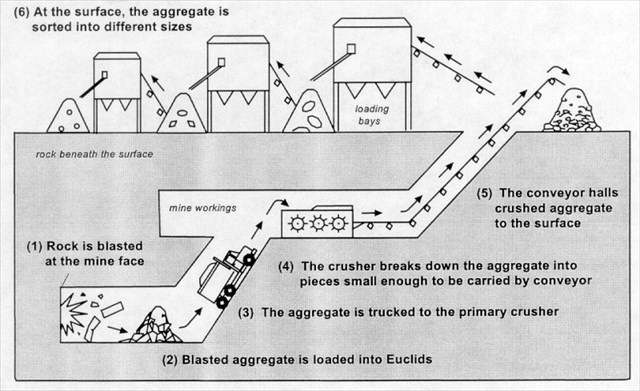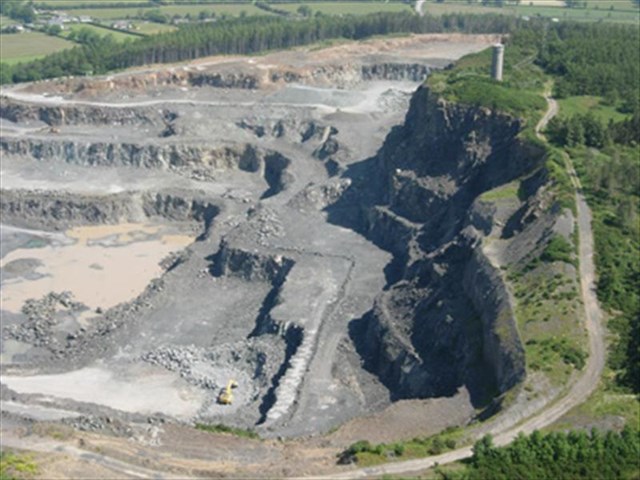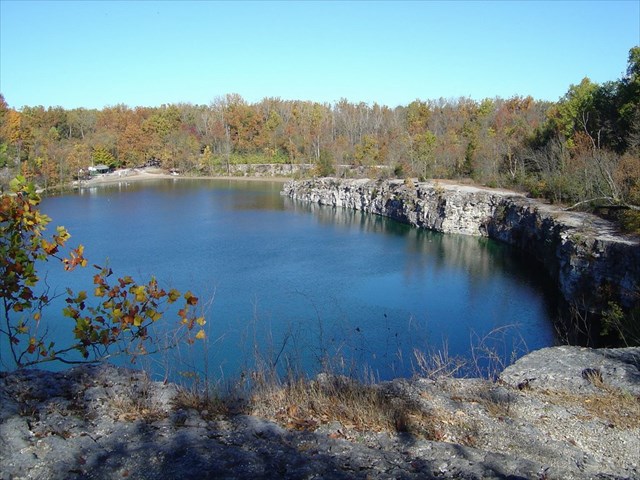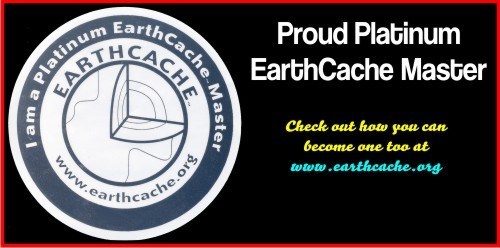"Old Kenneth Stone Quarry" gets its name from its location along U.S. 24 at Kenneth, Indiana. Beginning in the late 1800's, large amounts of limestone were mined at this site and used all across the country. Over time, the quarry began to fill with spring water as there were no exiting run off areas deeper than the mined quarry. Today, it has become a clear and natural lake and a home to many species of freshwater aquatic life. At its deepest point, the lake is 30 feet deep and is home to the prehistoric Spoonbill Sturgeon.
A rock quarry is a large deposit of rock which is mined for use in construction projects. Quarries can be found all over the world, and most contain a heavy concentration of a particular type of rock such as Marble, Limestone, slate, Chalk, China clay, Cinder, Clay, Coal, Construction aggregate (sand and gravel), Coquina, Granite, Gritstone, Gypsum, Ores, Phosphate rock, Sandstone, gypsum. In many nations, the word quarry is used interchangeably for two types of quarry: gravel pits, from which gravel and particulate matter are extracted, and dimension stone quarries, from which large chunks of sheets of rock are extracted for use in building. Old Kenneth Quarry is a dimension stone quarry. Limestone was extracted at this location due to its long-lasting durability and multiple uses in construction projects. Because of impurities, such as clay, sand, organic remains, iron oxide and other materials, many limestone's exhibit different colors, especially on weathered surfaces. You will see this evident along the eastern "walls" of this quarry. There is a large elevation discrepancy from the southeastern side of the quarry to the northwestern side of the quarry. During the extraction of the large amounts of limestone from this location, the construction vehicles needed access to US 24 to transport the stone. They quarried the northwestern section of the quarry initially to give them an access point to the quarry as well as the adjoining highway. The quarrying here was much more shallow to create a progressive drop into the limestone. As the quarry operation pushed south and east, the excavation companies were able to quarry deeper due to a seasoned access road thus creating the lake foundation seen today.

Unlike other types of mines, a quarry is usually not dug out underground, and rarely reaches a significant depths. A shallow pit is excavated into a deposit of rock which runs close to the surface, and the pit is slowly expanded to remove valuable rock material. If the quarry is being used to extract gravel or fill, explosives may be used to break it up before it is removed and loaded into trucks. If dimension stone is required, the excavation process is more painstaking to ensure that the stone is not damaged.

Quarrying by blasting is prevalent throughout history and began with the first use of gunpowder around 1627. A hole about 2 inches in diameter and 12 to 20 inches deep drilled into the rock is the "point" of a triangle carved into the rock to direct the blast. The "plug-and-feather" method improved on blasting. Small holes were drilled with shims (thin wedge-shaped objects) and wedges inserted. Force was then applied to split the stone so that it broke with a flat face. Another technique used -- the flat wedge method -- is not in use today. A chisel chipped out a line of holes into which wedges were inserted and then tapped in sequence to let the stone split on its own.
Today's methods of quarrying are technologically advanced and customized for the location. At some marble quarries in Europe, diamond chainsaws cut the stone, and then the entire rock face is pulled off with construction equipment or broken into blocks and further trimmed with chainsaws. In a Brazilian quarry, oxygen burners create large vertical cuts and diamond chainsaws create smaller ones; then blocks are cut out. In a Vermont slate quarry, blasting is used along with a "softer hit" of black powder to loosen the stone.
While a quarry is in active operation, it must be protected from groundwater seepage and rain, or it will turn into a small pond or lake. Many quarries are surrounded with moats of impermeable material to prevent seepage, and are also covered to prevent rain from accumulating in the open pit. In some cases, pumps may be installed to assist with removing water from the quarry. The company which built the quarry also maintains roads to and from the site, and sometimes builds a temporary processing center for the rock so that it can be removed, graded, and processed on site, with excess being disposed at the site rather than miles away.
After a quarry is abandoned, it is usually fenced off or otherwise secured to prevent people from injuring themselves there. In some cases there may be toxins present at the site, due to the way in which the rock was extracted. In others, as the quarry slowly fills with rainwater or natural springs, it may be a tempting place to swim. However, the quarry may pose hazards to swimming through objects in the water, depth, coldness, or toxins which may have leached into the water. In some cases, an inactive quarry may be converted into a swimming area, with modifications made to create a safe swimming and recreation area. When selecting a technique for quarrying, the environmental impact is a consideration. Quarrying can ruin the beauty of an area and affect local wildlife; the machinery and trucks can cause pollution and noise. The land will never return to the way it was after quarrying, but with planning, a gravel and sand pit can become a leisure facility like a lake or a home for local wildlife. The later was the case for Kenneth Quarry which is now surrounded by France Park.

I expect the required logging information for this earthcache to be sent to me within three days or the "Found It" log will be in jeopardy of deletion. Please answer the following questions correctly in order to be able to claim the smiley for this cache.
1. What are the varying colors that are displayed on the eastern quarry "walls" under the quarry overlook?
2. Take an elevation reading anywhere on the beach. Note the elevation. Take an elevation reading at the top of the trail leading to the quarry overlook at the parks' zip-line feature. Note the elevation. What is the difference in the elevations (or elevation change from the beach to the overlook/zip-line area)?
3. Please post a picture of yourself at the overlook or with the overlook in the background (not required).
